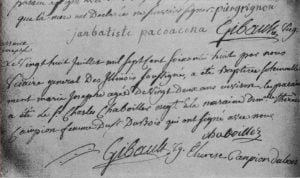The records from the register at Michilimackinac are here provided as they were translated by Edward O. Brown back in 1889. His translation came from a transcript of the original, which latter is kept in the parish church of Ste. Anne, at Mackinac.
There are large gaps in the records which was caused by a variety of reasons. One can glean from the actual records that at times there was no priest available to baptize, marry, or bury the citizens and visitors of the outpost. Another reason for the large gaps was the influx and outflow of some families who held allegiance to the French, British or American causes. The decades between 1760-1790 hold the least amount of records, and then from about 1804-1821 they stopped recording within the register, until 1821 when many records were recorded which encompassed the preceding years. The 1760 timeline coincides with Pontiac’s Conspiracy and the British takeover of the area, and 1792 coincides with “J. P.” Justice of the Peace officiating over most of the baptisms, marriages and burials, though some Catholics still had the visiting priests conduct them. It is possible and likely that during the periods of absence in the records, these life events were officiated elsewhere, such as Cahokia, Chicago, Detroit, Kaskaskia, La Pointe, Penetanguishene, Prairie du Chien or Sault St. Marie.

In 1757 a great smallpox epidemic was brought to Mackinac and all the upper country by the Indians returning from the Lake Champlain expedition of 1757. During the siege of Fort William Henry, smallpox broke out among the garrison and several died and were buried. Not content with breaking the capitulation the Indians of the North exhumed the recently buried members of the garrison in order to scalp the corpses, and thus add to their ghastly trophies. In this way they themselves caught the contagion, which they carried with them to Mackinac and beyond. 1
Annotated throughout are Mr. Brown’s biographical knowledge of the events of Michilimackinac and the people within. Don’t pass over the footnotes for the record, you may find a biographical reference hidden there!
- A Short History of Michilimakinak
No more colorful settlement existed in the Middle West than the mission and fort at the Straits of Mackinac, for the French early realized its importance and directed their westward explorations from this base. The concentration point for the fur trade of the Middle West, Mackinac held an important place for many years, both during the British and American regimes. - Miscellaneous Notes In The Mackinac Registers
In the original Mackinac Register these are scattered through the register, in the neighborhood of entries on other subjects. They are here brought together under one head. - Register of Baptisms in the Parish of Michilimackinac
The collection of baptismal records shine the best light on the settlement at Mackinac. They also provide more information then just baptisms, providing connections between father and mother that may not be described in the official marriage records. They also show adoptions, illegitimate births, Indian births, as well as black free and slave births. - Register Of Marriages in the Parish of Michilimackinac
There are not a lot of marriage records here, and unfortunately, the very early ones are lost – of those copied over to the new register (1725-1741) much of the information was torn away from the manuscript by the time Edward Brown viewed it. However, within the marriages completely recorded there is a treasure trove of information. - Register of Interments in the Parish of Michilimackinac
The register of interments was evidently not as carefully kept as those of marriages and baptisms. The four entries were abstracted from the baptismal register, being entered after the records of baptisms on the death of the child previously baptized. The record kept by Father Le Franc, beginning in 1754 and continuing through 1760, is continuous, and entered in one portion of the register, headed “Registre des morts depuis le ler aoust 1754” 2. The remaining entries were scattered miscellaneously among the marriages and baptisms, but have here been assembled in chronological order.
See further:
- F. B. Hough, Journals of Major Robert Rogers, Albany, 1833, p. 78;
- François Pouchot, War in America, 1155-60, Roxbury, Mass., 1866, i, pp. 91, 92. The latter says that the Potawatomi were almost extinguished.
- Fuller, George N. A history of the upper peninsula of Michigan. Dayton, Ohio: National Historical Association, Inc. 1926
Citations:
- Wisconsin Historical Collections, xviiii, pp. 203, 205. [↩]
- Register of deaths after August 1, 1754 [↩]
